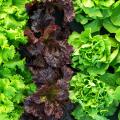Tomatoes
Tomatoes

The tomato is the most popular garden vegetable. Tomatoes come in many shapes, sizes, and colors, but the most popular is the medium-sized (6 to 8 ounces) red globe.
Tomato plants require full sun, moderate amounts of fertilizer, staking or caging, and an insect and disease control program. Determinate (short, self-topping) varieties like Celebrity, Mountain Pride, and Mountain Spring are gaining in popularity, but the indeterminate varieties like Better Boy are used more widely.
Most tomatoes are set out as transplants, since it takes several weeks longer to harvest from tomatoes planted as seeds. Do not set out transplants too early in the spring. Cool soils as well as cool air temperatures chill plants, resulting in delayed harvest. Use a starter solution when setting the transplants. If transplants have small fruit at planting time, remove fruit to prevent stunting the plants.
Plants set out in spring are sometimes maintained through the summer in hopes of a fall crop. With mulching, irrigation, fertilization, and a good pest control program, this is possible, but the fall fruit that develop are frequently small. This results from failure to maintain a season-long pruning program. A second planting of tomatoes for a fall crop provides large, attractive fruit. Start seedlings in June and set plants out in July or early August. You can use rooted cuttings (suckers) that were removed in pruning to start a second planting.
Set tomato transplants deeper than they were growing in the plant bed, peat cup, or plastic tray; the deeper the better.
All garden tomato plants, indeterminate as well as determinate, must be supported off the ground in some manner to prevent loss of fruit to rots and sunburn. Wooden stakes, placed at planting time or shortly after, are the most common type of support.
Wire cages at least 18 inches in diameter made from concrete reinforcing wire are also popular. Cages wrapped with clear plastic to a height of 18 inches provide some protection from cold winds and wind-blown sand. Black plastic mulch laid before planting, in combination with plastic-wrapped cages, is beneficial to early plants.
Staked plants in a row do not have to be tied directly to the stakes. They can be supported by nylon cord that runs from stake to stake, down the row on both sides of the stakes, and at several levels (Florida weave).
Tomato plants form many branches (suckers) as they grow. It is a common practice to break the suckers out of the plants to encourage larger and earlier fruit and to make the plant easier to tie and spray. Determinate types are not pruned as heavily as indeterminate types, and in no instance are all the suckers removed.
Products advertised to promote fruit development by spraying on the flower clusters are useful at times but should not be counted on for all the fruit set. When conditions are not ideal (shade; cool, wet weather; high temperatures) for natural pollination, these sprays are useful. Fruit that develop entirely from these sprays, with no natural pollination, do not have seeds and are not the best quality.
Tomatoes are attacked by a number of diseases and insects. The most serious diseases are early blight (no resistant varieties), spotted wilt virus (BHN 444 and Amelia are resistant varieties), fusarium wilt, blossom end rot, and root knot nematodes. Regular use of fungicides containing maneb or chlorothalonil controls early blight and several other leaf and fruit diseases. Plant disease-resistant varieties to reduce disease problems. Disease resistance is indicated in the variety descriptions below by a series of letters, V, F, N, and T. The V indicates resistance to verticillium wilt, F for fusarium wilt, N for root knot nematodes, and T for tobacco mosaic virus.
Major insect problems are aphids, thrips, stink bugs, blister beetles, fruit worms, horn worms, leaf miners, and white flies.
Problems are blossom end rot (low soil calcium, lack of water), fruit cracking (excess water and high temperatures), sudden wilting (root damage from cultivation or drowning), blossom drop (low or high temperatures, poor nutrition), and sunscald (excessive pruning, no plant support, or loss of leaves to disease).
Varieties
- I--indeterminate
- D--determinate
- Amelia—large-fruited with tomato spotted wilt virus resistance; D.
- Better Boy—VFN hybrid; 8- to 12-ounce red fruit; 72 days; I.
- Big Beef—large-fruited beef stake with good disease resistance; I; AAS 1994 .
- Celebrity—VFNT hybrid; 7- to 8-ounce red globe; firm, flavorful fruit; D; 72 days; AAS 1984.
- Cherry Grande—VF hybrid; large cluster of 11⁄2-inch firm, round, red fruit; D; 60 days.
- Floramerica—VF hybrid; 8- to 12-ounce red fruit; 76 days; D; AAS 1978.
- Floradel—F; 8-ounce red fruit; 75 to 85 days; I; old variety; open-pollinated.
- Marion—F; 6-ounce red fruit; 79 days; I; old; open-pollinated.
- Mini Charm—miniature cherry tomato with indeterminate growth and abundant production.
- Mountain Spring—VF hybrid; early; resistance to cracking; D.
- Park’s Whopper—VFNT hybrid; large fruit; I; 70 days.
- Super Fantastic—VF hybrid; 8-ounce red fruit; 70 days; I.
- Sweet 100—hybrid; large clusters of 1-inch, round, red fruit; I; 65 days.
Publications
News
If you grow your own vegetables, you will likely see at least a few pesky insects that want to feed on your plants. Slugs are one of the pests you may be noticing now.
Did you know yellow squash is in the pumpkin family and are 95 percent water?
Tomatoes are a popular crop, both for commercial growers and home gardeners. Even the best tomato growers run into problems along the way! We put together a simple, easy-to-follow guide to help you spot a few of the most common tomato troubles gardeners see.




